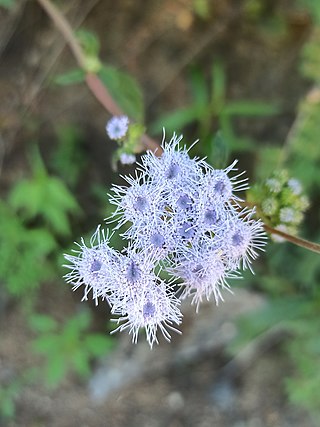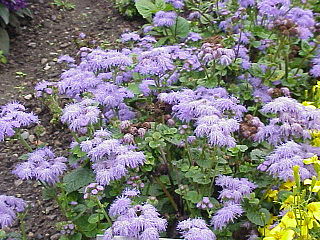
Ageratina, commonly known as snakeroot, is a genus of more than 330 perennials and rounded shrubs in the family Asteraceae.

Ageratum is a genus of 40 to 60 tropical and warm temperate flowering annuals and perennials from the family Asteraceae, tribe Eupatorieae. Most species are native to Central America and Mexico but four are native to the United States.

The Heliantheae are the third-largest tribe in the sunflower family (Asteraceae). With some 190 genera and nearly 2500 recognized species, only the tribes Senecioneae and Astereae are larger. The name is derived from the genus Helianthus, which is Greek for sun flower. Most genera and species are found in North America and South America. A few genera are pantropical.

Eupatorieae is a tribe of over 2000 species of plants in the family Asteraceae. Most of the species are native to tropical, subtropical, and warm temperate areas of the Americas, but some are found elsewhere. Well-known members are Stevia rebaudiana, a number of medicinal plants (Eupatorium), and a variety of late summer to autumn blooming garden flowers, including Ageratum (flossflower), Conoclinium (mistflower), and Liatris.

Baccharis is a genus of perennials and shrubs in the aster family (Asteraceae). They are commonly known as baccharises but sometimes referred to as "brooms", because many members have small thin leaves resembling the true brooms. They are not at all related to these however, but belong to an entirely different lineage of eudicots. B. halimifolia is commonly known as "groundsel bush", however true groundsels are found in the genus Senecio.

Critonia is a genus of flowering plants in the tribe Eupatorieae of the family Asteraceae.
Cronquistianthus is a genus of shrubs native to the Andes in Colombia, Ecuador, and Peru.

Fleischmannia is a genus of flowering plant in the family Asteraceae. The name honours Gottfried F. Fleischmann (1777–1850), the teacher of Carl Heinrich Schultz at University of Erlangen–Nuremberg. Members of the genus are native to South, Central, and North America, with some species found as far north as Virginia and Illinois. They are commonly known as thoroughworts.
Grosvenoria is a genus of South American shrubs and small trees in the family Asteraceae. They are native to the Andes, from central Ecuador to northern Peru at elevations of 2,700 to 3,700 metres.
Hebeclinium is a genus of flowering plants in the family Asteraceae, native to South America and Mesoamerica.
Kaunia is a genus of South American shrubs or small trees in the family Asteraceae. Its range is centered in Bolivia but it is also found in Argentina, southern Brazil, Peru and Ecuador.
Phalacraea is a genus of South American plants in the tribe Eupatorieae within the family Asteraceae.

Pseudogynoxys is a genus of flowering plant in the groundsel tribe within the sunflower family, native to North and South America.

Austroeupatorium is a genus of plants native primarily to South America, including herbaceous perennials and shrubs. The native range is focused on eastern South America and extends as far north as Panama and Trinidad and as far west as Bolivia.
Lourteigia is a genus of South American flowering plants in the tribe Eupatorieae within the family Asteraceae.
Oxylobus is a genus of Mesoamerican flowering plants in the tribe Eupatorieae within the family Asteraceae.

Tridax is a genus of flowering plants in the family Asteraceae.

Vernonanthura is a genus of Neotropical plants in the tribe Vernonieae within the family Asteraceae.











